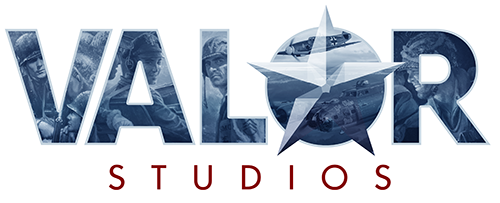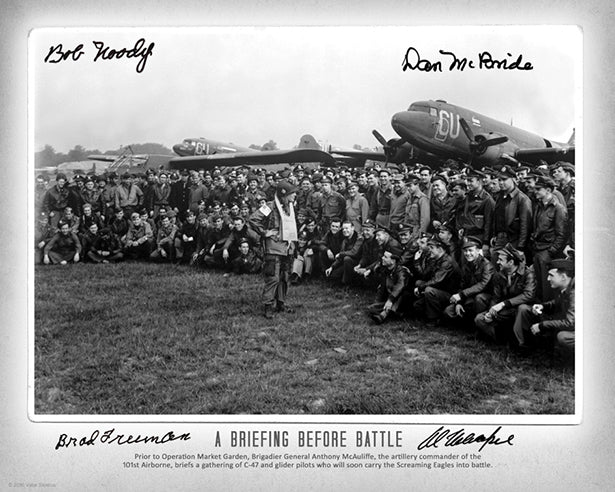

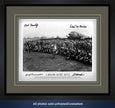
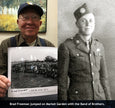
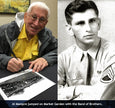
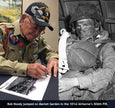
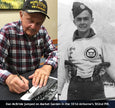
"A Briefing Before Battle" photo autographed by WWII paratroopers
- DESCRIPTION
- SIGNERS
- PHOTO CARE
-
General Anthony McAuliffe, the artillery commander of the 101st Airborne, briefs a gathering of C-47 and glider pilots of 9th Troop Carrier Command before Operation Market Garden. We have this photo available with two different signature options:
FOUR SIGNATURE VERSION - In low supply!
Autographed in marker by Market Garden paratroopers Brad Freeman, Al Mampre, Dan McBride, and Bob Noody.
ONE SIGNATURE VERSION - Less than 20 remain!
Autographed in marker by Market Garden paratrooper Brad Freeman, who was the last-living Band of Brothers veteran.
Shipping added in checkout // photo size: 8" x 10" // ships flat in a heavy-duty envelope -
BRAD FREEMAN
Bradford Freeman was born and raised in the lush Mississippi farmlands of Lowndes County, near Columbus. He was one of 8 children, 3 of whom fought in the war. After high school graduation he enrolled in Mississippi State University, which he attended for one semester before enlisting in the US Army on December 12, 1942.
He joined the paratroopers, following in the footsteps of his older brother, who became an officer in the 11th Airborne. Freeman was assigned to the 506th PIR., 101st Airborne at Alderbourne, England in February 1944. There, he trained under the watchful eye of mortar squad leader Don Malarkey and platoon leader Bill Guarnere, both of whom he describes as great fighting men.
On D-Day Freeman parachuted into Normandy in Malarkey’s stick, forming up and fighting with Sgt. Chuck Grant until they joined the company near Brecourt Manor. Freeman vividly remembers the fierce fighting at Carentan, where he feels E-Company came together as a combat unit.
Freeman participated in the invasion of Holland, and recalls endless patrols and “scary” night outpost duty on the banks of the Rhine. Following Market Garden Freeman survived the brutal weather and constant shelling in the Bois Jacques woods at Bastogne only to be wounded by a “screaming mimi” (Nebelwerfer rocket) in Easy Company’s attack on Foy. Following release from a hospital in England, Freeman joined up with HQ Staff in Berchtesgaden in April 1945, and later with his E-Company comrades in Kaprun, Austria.
After the war Brad Freeman went back to Mississippi State University for a semester, and then returned to help run a 197 acre family farm in Lowndes County. He later worked with the US Postal Service, retiring after 32 years of service.
AL MAMPRE
Al enlisted in 1942 and volunteered for the paratroopers. He was assigned to Easy Company, 506th PIR, 101st Airborne as a medic at Toccoa, Georgia. Prior to D-Day, Mampre developed a serious infection and was sent to the hospital, thus missing that jump.
He rejoined Easy Company in time for Operation Market Garden, his first combat jump. Soon after, Easy Company Lieutenant Bob Brewer was shot by a sniper outside of Eindhoven. Mampre immediately jumped to his aid and while providing medical assistance to Brewer, was also shot by the sniper, through the leg. This incident was depicted in "Band of Brothers" during Episode 4, "Replacements."
After several weeks of recovery, Mampre rejoined Easy Company in Mourmelon, France, in time to accompany them into Bastogne during the Battle of the Bulge. Towards the end of the war, Mampre was reassigned as a medic to regimental headquarters and continued to serve in this role during the 101st Airborne's time in Berchtesgaden and later in Austria.
DAN MCBRIDE
Dan volunteered for the paratroopers after seeing a newsreel about them in his hometown of Conneaut, Ohio. Despite being scared of heights, he succeeded in the role and found himself in F-Company, 502nd PIR, 101st Airborne. On D-Day, Dan jumped while his C-47 was in a bank which resulted in him going out the door headfirst, slamming into the earth upside down, and being knocked out. Once conscious, he gathered himself and began a trek through the countryside where he silenced a German MG position with a grenade. Soon after, he linked up with an 82nd Airborne trooper, and they knocked out a German staff car, stole it, and made their way to Ste. Mere Eglise. Following that fighting, Dan would rejoin his outfit only to be shot through the arm during a night patrol. After recovering from that wound, he jumped into Holland for Operation Market Garden and fought until blown off a dyke by mortar shells, crushing his ankle. Once again, recovering from his wounds, Dan rejoined his company in time for the defense of Bastogne, where he received his third war wound - this time shrapnel in the knees from a German tank shell. Dan would go back on the line and remain with F-Company through VE-Day.
BOB NOODY
Bob Noody joined the Army in February 1943, shortly after his 18th birthday. He volunteered for the paratroopers, not knowing what that was about, except that it meant an additional $50 per month. His arrival at Ft. Benning was an eye-opener, yet he survived the “brutal training.” He joined Fox Company, 506th PIR, 101st Airborne at Aldbourne, England, just in time for the Normandy invasion.
On the evening of June 5, 1944, at Upottery Airfield, Noody was immortalized in a photo taken of him aboard his C-47 immediately before takeoff. The photo was first published on the cover of an Army Air Forces magazine and it took on a life of its own afterward. In the picture Bob remembers he must have weighed at least 250 lbs., encumbered with his M-1 rifle, a bazooka, three rockets, land mines, and other assorted “necessities.”
Fifty feet of rope hung from his chest, which he later used to lower his leg bag to the ground, easing his fall and ensuring he was ready to fight. He landed behind the mayor’s house at Ste. Mere-Eglise. In the ensuing days, Noody utilized his bazooka to destroy a German tank that threatened his unit outside of Carentan. It was his first and last bazooka usage, as he expended the three rockets he carried into battle. A leg wound at Carentan ended his Normandy adventure.
Noody recovered from his wounds in time to make the Market Garden jump. He fought with Fox Company from Eindhoven to the Rhine. While recovering from the exhaustive Holland campaign, Noody and his unit were rushed by truck to stem the German breakthrough at Bastogne. He froze in regular fatigues, holding the line in the Bois Jacques woods next to Easy Company, above the town of Foy. He survived the patrols and constant shelling only to be wounded during a nighttime recon patrol of Foy prior to Easy Company’s assault on the town. Noody was wounded by friendly fire when a comrade dropped a live grenade while they sought refuge in a small house outside of Foy.
Noody recovered from his wounds in time to join his unit at Hagenau. He vividly recalls lying in a graveyard on the German side of the river at night during an attempt to take prisoners. As fighting ensued a friend whispered, “Boy, what a convenient place to die.” He survived the patrol only to discover that the “Grease Gun” he carried was defective.
As the war ended, Noody celebrated with his unit in Berchtesgarden. One day, searching a train hidden in a tunnel, he retrieved a hand-crafted ceremonial sword belonging to Herman Goering. With the help of his friends he managed to get his prize home to America, where it now resides in a private museum collection.
Noody completed his wartime duty in Zell Am Zee, Austria, and returned to the US where he received his discharge in November 1945 at Ft. Dix, New Jersey. - We recommend that all autographed items be displayed or stored using archival quality, acid free materials away from any moisture or strong light exposure. When framing art/photographs/posters, we recommend locating a framer who is familiar with archival framing, has a storefront so you can see examples of their work, is not within a big box store, and has full insurance in the event an accident occurs while framing your item.
UV blocking glass/acrylic, spacers, and acid free framing materials must be used to protect the image and signatures. Fading can occur even if an item is not displayed in direct sunlight (even a light bulb omits UV rays) so UV blocking glass/acrylic is necessary. Acid free spacers or mat board must also be utilized to prevent the signatures from direct contact with the top layer of glass/acrylic. If a signature is pressed against the clear material it will lift off the photo/poster/print and deteriorate.
In order to retain full value of your item, your art or collectible should be able to be removed from its frame or storage container and still be in the same original condition as it was when purchased from Valor Studios.
If you decide to store one of our art prints/collectibles without getting it framed, then we recommend flat storage in either an acid free art sleeve or between pieces of acid free foam core. The item should be stored in a dark and dry location, several inches off the floor. We do not recommend storing prints/posters/photos in tubes for any extended length of time.
$145 USD
